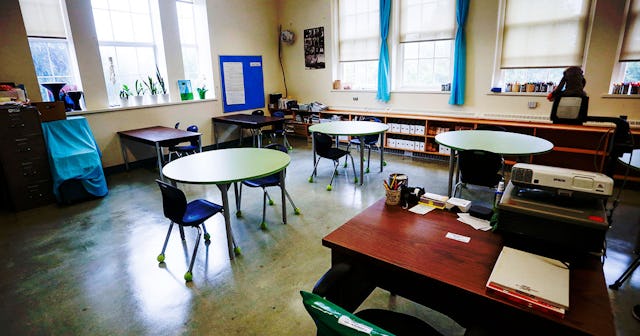B117 Variant Is Spreading Fast AF In Canada, Forcing Schools To Close

On April 6, Toronto, Canada’s largest city, immediately suspended all in person learning for two weeks due to a surge in COVID-19 cases. The closure affects more than 300,000 elementary and secondary school students, including private school students. The earliest they might return to class is April 18.
The shutdown was announced on a day when the city reported 955 new cases. In a statement, the Toronto Public Health (TPH), noted that “The spread of COVID-19 has never been greater in Toronto, with variants of concern increasing both the risk of transmission and the risk of serious illness or death,”
Health Officials Believe Variants Are Driving The Surge
Dr. Eileen de Villa, Toronto’s Medical Officer of Health, issued the order due in large part to the variants circulating around the country.
The B.1.1.7 variant first identified in the United Kingdom has “likely replaced the original virus in some locations,” according to Dr. Theresa Tam, the chief public health officer for Canada. She noted further an increase in P.1 variant cases, with cases due to that variant almost doubling from about 460 per week to 857, largely in British Columbia and Ontario.
In an interview with a Canadian news station, Dr. de Villa confirmed the highly transmissible nature of the variants was a driving force behind the decision to shut down schools. “[T]hey spread faster, and therefore the risk was greater,” de Villa said. “So we really had no choice but to take this kind of action.”
The Shutdown Is An Attempt To Halt Community Spread
Zou Zheng/Xinhua/Getty
The decision to close schools was made after a steady increase in cases which are putting a “heavy strain on the health system in many places.”
Hospitalizations are up 4 percent from the week before and intensive care unit admissions are up 18 percent. A greater number of those being admitted and requiring treatment are younger adults, according to Tam. “This is a reminder that COVID-19 can impact people of all ages and severe illness can occur at any age.”
Toronto Public Health (TPH) acknowledged the value of in-person learning and noted that it “firmly believes that schools should be the first places in our community to open, and the last to close.”
The statement went on to say that, “Unfortunately, current circumstances require that difficult decisions must be taken locally to protect all those in our school communities, including students, teachers and staff.”
The U.S. Is Facing The Same Variant Problem As Canada
Dr. Rochelle Walensky, the C.D.C. director, confirmed that the B.1.1.7 variant is the source of most new COVID-19 infections. That could spell trouble for U.S. schools.
Dr. Michael Osterholm, the Director of the Center for Infectious Disease Research and Policy at the University of Minnesota was originally in favor of in-person education, but the B.1.1.7 variant has shifted his stance. He floated the idea of closing schools in a discussion on “Meet The Press,” where he also confirmed that 749 schools in Minnesota had cases of the B.1.1.7 variant first identified in the United Kingdom.
Dr. Osterholm noted that, “Unlike the previous strains of the virus, we didn’t see children under eighth grade get infected often, or they were not frequently very ill. They didn’t transmit to the rest of the community. That’s why I was one of those people very strongly supporting reopening in-class learning. B117 turns that on its head. These kids now are really major challenges in terms of how they transmit.”
The rise of variants and how they affect children could explain why some states are seeing a rise in cases in schools.
In Michigan, the state that has been one of the hardest hit by the pandemic recently, school outbreaks jumped 23 percent this past week and 47 percent over two weeks. Outbreaks tied to Michigan schools rose from 241 the previous week to 296 this week.
In a published statement, Ingham County Health Officer Linda Vail noted that she was “deeply concerned” after looking at the percent positivity, case numbers and hospitalizations. As of this writing, Michigan schools have not shut down, despite a shutdown in November when case numbers were lower than they are now.
Likewise, though on a smaller scale, a North Carolina elementary school pivoted temporarily to remote learning after more than 100 students, or more than 19 percent of students at the school, were required to quarantine.
Taken together, it’s not outside the realm of possibility that some U.S. schools will switch to remote learning, like Toronto.
The Big Difference Between Canada’s Surge and America’s Could Come Down To Vaccines
While noting the rising numbers in Michigan, Vail noted that she’s also “really hopeful” due to the vaccination rates. “We’re at a turning point in the pandemic.”
In the United States, nearly one-third of the population has received at least one dose of COVID-19 vaccine. The vaccination program has been slower in Canada, where only 12 percent of the population is vaccinated as of the end of March.
Though children younger than 16 are not yet eligible for the vaccine, the more adults that are vaccinated, the less community spread is possible. Hopefully, the higher rate vaccination means less virus is circulating in a given community, which protects even the unvaccinated children.
It still might not be fast enough to prevent another surge and more school shutdowns. With rising case numbers and a highly transmissible variant in circulation, the U.S. might follow in Toronto schools’ footsteps, despite the efficient vaccine rollout. These next few days and weeks will be crucial in how that decision is made. In the meantime, it’s more important than ever to mask, social distance, and get the vaccine as soon as it’s your turn.